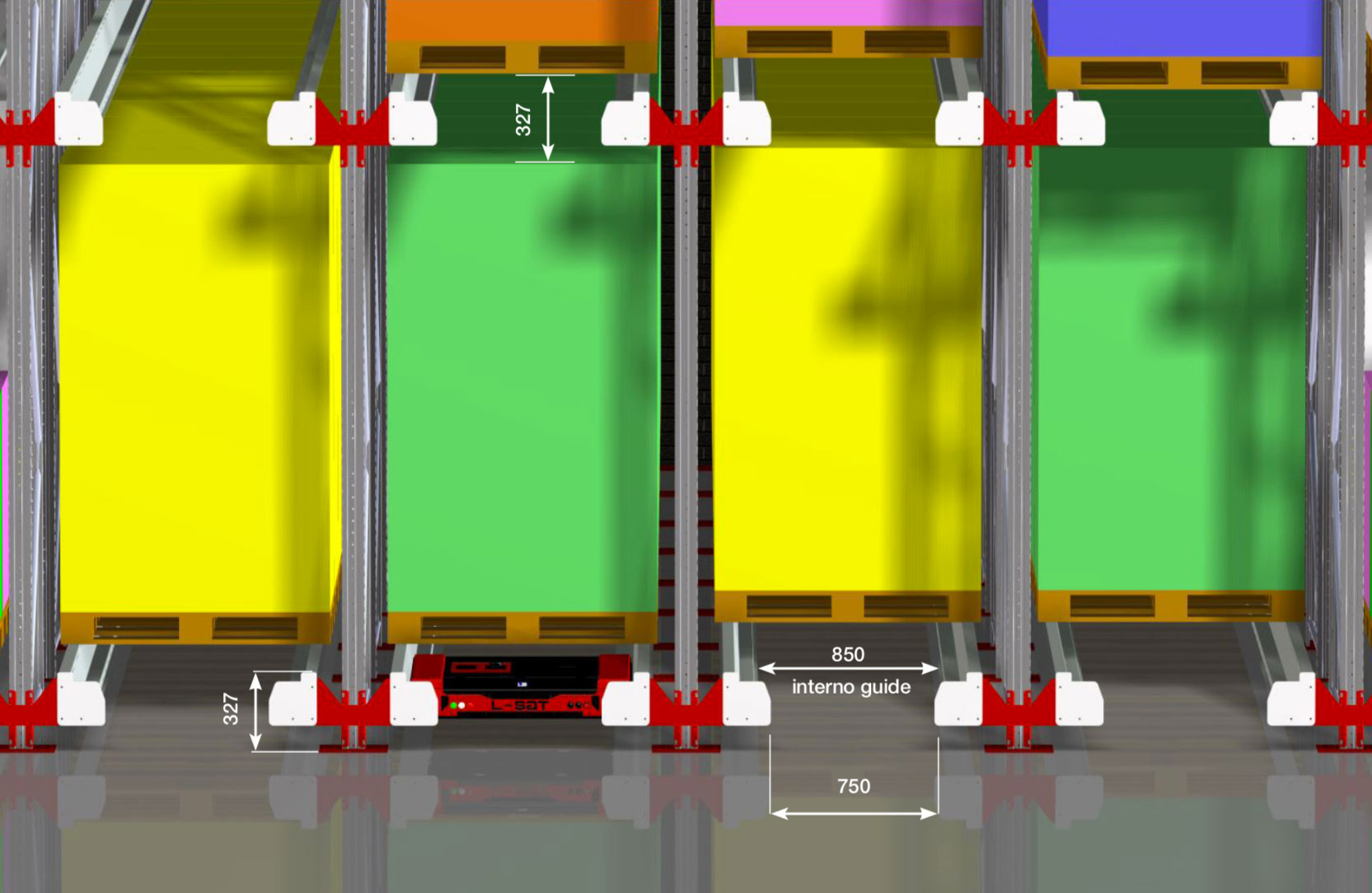L-Sat
Warehouse automation means more
efficiency speed and convenience
L-SAT is a satellite designed specifically to speed up deposit and pick-up operations inside drive-in structures with depths of 800, 1000 and 1200. L-SAT works autonomously in accordance with different warehouse logics and always in maximum safety. Choosing L-SAT means effectively organizing your warehouse, thus achieving excellent space optimisation and drastic time and labour savings. The operator no longer has to go up and down the storage lanes which means he can contrai one or more L-SATs with greater operating flexibility thanks to the easy-to-use remote control.
Different pallet types, even when stocked in the same lane, will no longer be a problem. From design through to construction, L-SAT is the result of entirely Italian technical know-how and is 100% Made in Logaut.
L-SAT is available in the following versions: L-SAT (800, 1000, 1200), L-SAT POLAR (800, 1000, 1200) for installation with subzero temperatures of up to -25°C, L-SAT Wi-Fi (800, 1000, 1200), Duplex.
Standard features: remote contrai, system for locking onto the forklift, automatic overhang reading, lithium-ion battery, battery charger, user manual.
Optional features: pallet film tail management system, trolley for battery charger
6 great reasons for choosing L-SAT
- lt is moved by a standard forklift truck; one or more L-SATs can be used in the same warehouse. lt will always provide silent operation.
- Intuitive remote contrai which can operate more than one L-SAT. Commands can be sent by a contrai system linked to the company management system (optional).
- Innovative 48-V lithium-ion battery with 8-hour autonomy which recharges in less than three hours. The integrateci BMS (Battery Management System) contrai which means it can be recharged over 2,000 times. Handy battery charger trolley (optional) powered by a standard 230 Vac 50/60 Hz socket.
- Fitted with a Laser-Scanner system for operator safety, it is also equipped with a laser positioner to optimize all pallet handling and simplify the housing structure.
- The Duplex version is designed so it can handle two loading units simultaneously.
- The Polar version is designed to operate at subzero temperatures of up to -25°C.
Furthermore it has:
- Maintenance-free brushless motors.
- Constant speed of 1 metre/second when both empty and fully loaded.
- Laser photocells for automatic pallet centring.
- All photocells can operate at working temperatures of between +45°C and -25°C (even the standard version).
- Pick-up height reduced to 175 mm.
- Automatic device for locking onto the forklift.
Standard functions
Loading: the L-SAT is positioned at the end of the selected lane by a forklift truck, the forklift operator places the pallet to be warehoused in the first loading position and sends the input “load”.
Unloading: the L-SAT is positioned at the end of the selected lane by a forklift truck, the forklift operator sends the “unload” input; L-SAT seeks the first useful pallet, picks it up and transfers it to the front of the shelving in the waiting station where it will be picked up by the operator.
Continuous unloading: if the “continuous unloading” command is sent, the L-SAT will perform unloading cycles, as described above, without the need to repeat the “unload” command. The mission ends when the operator sends the “end of continuous unloading” command.
Optional functions
- Anti-collision dual-front version
- Dual front operation
Continuous loading: by sending this command, the operator can position the load on the pick-up front at the start of the selected lane without having to send the “load” input to the L-SAT again. L-SAT will warehouse the pallets continuously, waiting for the next load at the end of each mission.
Multiple continuous unloading: this function speeds up the unloading mission. lt is different to “Continuous Unloading” in that a pallet is picked up even if the forklift operator has not yet taken off the previous one; the L-SAT then waits until the load has been removed.
IN or OUT front compacting: in the DUAL-FRONT version, the L-SAT automatically reorders the pallets in the selected lane, compacting them into free positions on one front or the other, for the purpose of speeding up the subsequent loading operations.
Anti-collision: this function avoids collisions if more than one L-SAT is working in the same lane.
Minimum recommended clearances

Loading/unloading operating logic
L-SAT enters the edge of the structure and takes the pallet into the envisaged lane for storage (operator side) as if it were a normai loading unit When the “load” or “continuous loading” command is given, the L-SAT picks up and deposits the load in the required position. Once the requested operation has been compieteci, the L-SAT goes to the start of the lane to perform the following mission or to be picked up and taken to a new lane. While the L-SAT performs the requested missions, the forklift operator is free to carry out other operations. When the forklift operator returns to the front of the deposiVpick-up lane, the L-SAT will already be in the expected operating position ready to accept a new command or, it having already transferred the load, in the operator pick-up position. The same operating logie is envisaged for the “pickup” and “continuous pick-up” operations.
Fl,FO, and Ll,FO, warehouse logic
There are different ways to organize logistics and assess stores; the main warehousing logistics are identified by the abbreviations FI. FO. and LI. FO.

FI.FO. logic (First In First Out): indicates the method whereby the first object to come out is the first one which was put in to ensure rotation of all products.

LI.FO. logic (Last In First Out): indicates the method whereby the last object put in is the first to come out